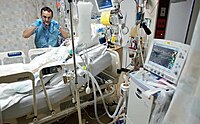
Photo from wikipedia
Purpose: Critically ill patients are at risk for short and long term morbidity. Early mobilization (EM) of critically ill adults is safe and feasible, with improvement in outcomes. There are… Click to show full abstract
Purpose: Critically ill patients are at risk for short and long term morbidity. Early mobilization (EM) of critically ill adults is safe and feasible, with improvement in outcomes. There are limited studies evaluating EM in pediatric critical care patients. Provider beliefs and concerns must be evaluated prior to EM implementation in the pediatric intensive care unit (PICU). Design and Methods: A survey was distributed to PICU providers assessing beliefs and concerns with regards to EM of PICU patients. Results: Seventy‐one providers responded. Most staff believed EM would be beneficial. The largest perceived benefits were decreased length of both stay and mechanical ventilation. The largest perceived concerns were risk of both endotracheal tube and central venous catheter dislodgement. Surveyed clinicians felt significantly more comfortable mobilizing the oldest as compared to the youngest patients (p < 0.0001). Clinicians also felt significantly more comfortable mobilizing patients receiving invasive mechanical ventilation in the oldest as compared to the youngest patients (p < 0.0001). Conclusion: There is clear benefit to the EM of adult ICU patients, with evidence supporting its safety and feasibility. As pediatric patients pose different challenges, it is imperative to understand provider concerns prior to the implementation of EM. Our research demonstrates similar concerns between adult and pediatric programs, with the addition of significant concern surrounding EM in very young children. Practice Implications: Understanding pediatric specific concerns with regards to EM will allow for the proper development and implementation of pediatric EM programs, allowing us to assess safety, feasibility, and ultimately outcomes. Highlights:Early Mobilization (EM) is both safe and feasible in adult critically ill patients, with significant benefits.It is necessary to understand pediatric specific barriers, concerns, and perceived benefits of EM prior to program development and implementation.Our study demonstrates the majority of providers believe EM would be beneficial. Largest concerns include dislodgement of equipment including endotracheal tubes and central lines.Clinicians were overall much more comfortable mobilizing older patients.
Journal Title: Journal of Pediatric Nursing
Year Published: 2018
Link to full text (if available)
Share on Social Media: Sign Up to like & get
recommendations!